 W
WThe Agrio River is a river of Argentina. The river starts in the Andes Mountains and eventually joins the Neuquén River.
 W
WThe Aluminé River is a geographical feature of Neuquén Province, Argentina. It flows southward from Lake Aluminé, near the town of Aluminé, for around 170 km (105 mi), past which it becomes a tributary of the Collón Curá River.
 W
WThe Atuel River is a river located mainly in the south of the Argentine province of Mendoza, with its last part in La Pampa. It is a tributary of the Desaguadero River.
 W
WThe Azul River is a river of Argentina.
 W
WThe Chalía River is a river of Argentina.
 W
WThe Chico River is a river of Chubut Province, Argentina. It is about 300 kilometres (190 mi) long, flowing in a northeasterly direction from the vicinity of Lake Colhue Huapi. It is a tributary of the Chubut River, joining it at the Florentino Ameghino Dam.
 W
WThe Chico River is a river, about 120 km (75 mi) long, flowing from Río Negro into Chubut Province, Argentina. Originating in the Andes foothills, it joins the Chubut River to the south of Cushamen.
 W
WThe Chimehuin River is a river in the northwest of the Patagonic Province of Neuquén, Argentina. Its origin is at Lake Huechulafquen and it passes by the city of Junín de los Andes. After a course of about 53 km, it merges with the Aluminé River to form the Collón Curá River.
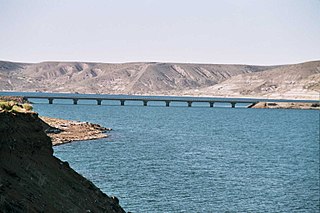 W
WThe Collón Curá River is a geographical feature of Neuquén Province, Argentina. It flows southward from the confluence of the Aluminé and Chimehuin Rivers, near the town of Junín de los Andes, for around 70 kilometres (43 mi), past which it becomes a tributary of the Limay River. The Collón Curá Formation and in turn the South American land mammal age Colloncuran are named after the river.
 W
WThe Correntoso River is a river located in Villa La Angostura, Argentina. This river runs from Correntoso Lake to Nahuel Huapi Lake, standing out as one of the shortest rivers in the world, with between 200 and 300 m in length. This river is famous among the fishing enthusiasts, due to the abundance of large trouts, especially at the mouth of Nahuel Huapi Lake.
 W
WThe Corriente River is a river in the Argentine province of Corrientes, in the Mesopotamia. It flows from the Itatí Lagoon, in the center-north of the province, and drains the large basin of the Iberá Wetlands, about 13,000 square kilometres (5,000 sq mi). It flows southwest, across marshes (bañados), and empties into the flood plain of the Paraná River near the city of Esquina.
 W
WThe Cosquín River is a small river in the province of Córdoba, Argentina. It is located in the area of the Punilla Valley and is part of the upper drainage basin of the Suquía River.
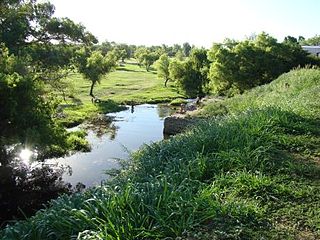 W
WThe Cruz del Eje River is a river in Argentina.
 W
WThe Cuarto River is a river of Argentina which crosses the southern part of the Province of Córdoba, and merges with the Tercero River to form the Carcarañá River. The Cuarto River is also known as Cochancharava, the name given to it by the Ranquel Indians.
 W
WDeseado River is a river in the Argentine province of Santa Cruz. The name Deseado comes from the English Desire, the name of one of the two ships commanded by John Davis during the Thomas Cavendish expedition of 1592.
 W
WThe Dulce River is the most important river in the Argentine province of Santiago del Estero.
 W
WThe Fuego River is a river of Argentina.
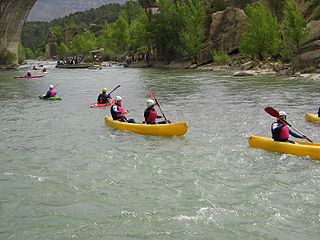 W
WThe Gallegos River is a river in the Argentine province of Santa Cruz, on whose estuary lies Río Gallegos city, capital of the province.
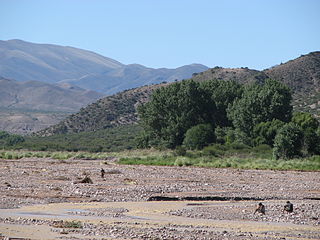 W
WThe Rio Grande is a river of Argentina.
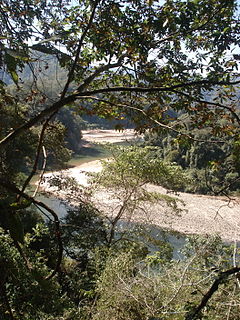 W
WThe Río Grande de Tarija is a river of Argentina and Bolivia. It is a tributary of the Bermejo River. It is also known as the Río Tarija and the Tarija River.
 W
WThe Río Grande is a river located on the island of Tierra del Fuego.
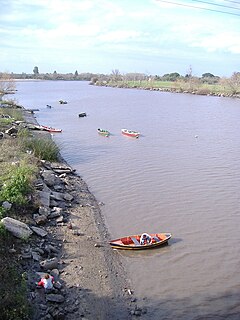 W
WThe Gualeguaychú River is a river in the province of Entre Ríos, Argentina. It starts in the center-east of the province, within the Colón Department, and flows south, passing by the city of Gualeguaychú and then emptying into the Uruguay River. Its drainage basin has an area of 6,693 square kilometres (2,584 sq mi).
 W
WThe Guayquiraró River is a river in the Mesopotamic northeastern region of Argentina. It is born in the middle section of the border between the provinces of Entre Ríos and Corrientes, fed from several streams on its right-hand basin. It flows west along the interprovincial border for about 110 kilometres (68 mi), then emptying into the Paraná River, at a base level of about 26 metres (85 ft) AMSL.
 W
WThe Huaco River is a river of Argentina.
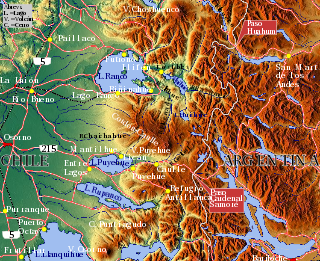 W
WThe Huahum River is a river in southern Chile and Argentina. It drains the waters of Lácar Lake in Argentina to Pirihueico Lake in Chile. The river gives name to Huahum Pass, an international mountain pass on the border between Chile and Argentina.
 W
WThe Iruya River is a river of Argentina. It is a tributary of the Pescado River.
 W
WThe La Leona River is a river of Patagonia, Argentina. It flows in the eastern part of the Los Glaciares National Park. It has its origin to the south of Lake Viedma and winds for about 50 kilometers through the Andes before flowing into Lake Argentino.
 W
WLa Quiaca River, also known as Villazón River, is a river of reduced flow on the border between Argentina and Bolivia. It is highly contaminated in its passage through the cities of La Quiaca and Villazón, on its right and left margins, respectively.
 W
WThe Luján River runs from its source near Espora about 100 kilometres (62 mi) east of Buenos Aires, Argentina, to its outflow into the Río de la Plata north of the city. The first Megatherium fossil was found here in 1789.
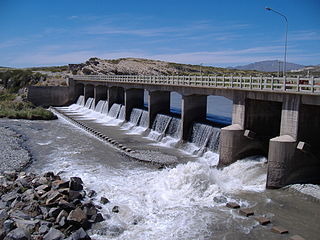 W
WThe Malargüe River is a river located in the southern zone of the Mendoza Province, in the west of Argentina. It originates in the Malargüe lake in the Andes range, at 2,500 m above mean sea level, flows into the Malargüe Department and ends in the Llancanelo Lake, being its main tributary.
 W
WThe Mayer River is a river of Argentina, where it originates, and Chile. It flows into the O'Higgins/San Martin Lake, the deepest lake in the Americas.
 W
WThe Mendoza River is a river in the province of Mendoza, Argentina. It is formed in the Andes range between the Aconcagua and the Tupungato, by the confluence of the Vacas, the Cuevas and the Tupungato rivers, the last being its major tributary.
 W
WThe Mocoretá River is a river in the Mesopotamic northeastern region of Argentina. It is born in the southeast of the province of Corrientes, south of Curuzú Cuatiá. It flows south, first turning east and then west until reaching the interprovincial border with Entre Ríos, where it receives the Las Tunas Stream. It turns southeast again along the border, passes by the town of Mocoretá, and empties into the Uruguay River, into the southern part of the Salto Grande reservoir.
 W
WArroyo Napostá is located in the region of Bahía Blanca, Buenos Aires Province, Argentina
 W
WRío Negro is a river in the Chaco Province in Argentina. It crosses the Chaco National Park and flows southeast. Near its mouth it flows by the cities of Puerto Tirol, Resistencia, and Barranqueras, where it finally reaches Barranqueras River, an arm of the Paraná River.
 W
WThe Nogoya River is a river of Argentina. It is a tributary of the Paraná River, which it joins in a region of wetlands and complex distributaries.
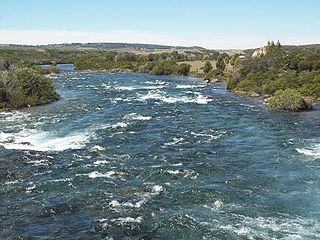 W
WThe Palena River or Carrenleufú is a river shared by Chile and Argentina in Northern Patagonia. It drains the waters of the Vintter Lake, also shared by these nations, and it flows into the Pacific Ocean.
 W
WThe Río de los Patos is a river of Argentina.
 W
WThe Pepiri-Guazu River is a river of Argentina and the Santa Catarina state in southeastern Brazil. For its entire course, it forms a short portion of the international border between Argentina and Brazil. It flows from north to south into the Uruguay River.
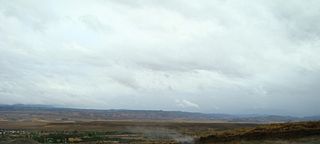 W
WThe Pico River is a binational river of Patagonian Argentina and Chile. It is a tributary of the Figueroa River which it enters near El Manzanito in Chile. The Pico Rivers arises at the confluence of the Río Tromencó and the Río de las Mulas in Tehuelches Department, Chubut Province, Argentina, about 5.5 kilometres (3.4 mi) east-southeast of the village of Río Pico and about 40 kilometres (25 mi) east of the Chilean border. The river was named in honour of the engineer Octavio Pico y Burgess (1837–1892), who headed the Boundary Commission that settled the border conflict between Argentina and Chile.
 W
WThe Pinturas River is a river in Patagonia, Argentina, running through the Pinturas River Canyon, near the Cueva de las Manos archeological site.
 W
WThe Puelo River has its origin in Lake Puelo in Argentine, and flows north-west through the Andes into Chile and the Reloncaví Estuary of the Reloncaví Sound at the northern end of the Gulf of Ancud.
 W
WThe Quequén Grande River is located in southestern Buenos Aires Province, Argentina. Its mouth flows into the Atlantic Ocean, along the eastern border of the resort city of Necochea. Discovered in 1748 by Jesuit missionaries José Cardiel and Thomas Falkner, they originally named the waterway San José; its eventual name originated from the gününa iajëch Kem Kem ("gully"). The Port of Quequén, located in the neighboring town of the same name, was established in 1922. The facility handles over 3 million tons of freight annually and is a major rail head for Argentine grain exports. One of only two existing suspension bridges in Argentina, the Hipólito Yrigoyen Bridge (1929), spans the river at Necochea.
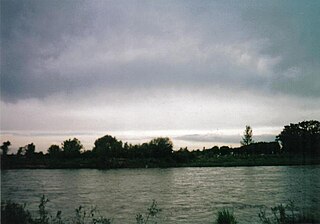 W
WThe Quinto River, also known as the Popopis, is in central Argentina.
 W
WRío Grande is a river located in Malargüe Department of southwestern Mendoza Province, Argentina. It arises in the confluence of the rivers Cobre and Tordillo on the Andes range near Chile and ends at the Colorado River at the Neuquén Province border. Its total length is 275 kilometres (171 mi). It's the most plentiful river of Mendoza with a flow of 107 m3/s (3,800 cu ft/s).
 W
WThe Rosario River is a river in Argentina.
 W
WThe Salado River is a river in northern Buenos Aires Province, Argentina. It originates at El Chañar Lake on the boundary with Santa Fe Province, 40 metres (130 ft) above mean sea level, and flows generally southeast for 640 kilometres (400 mi) before debouching into Samborombón Bay, part of the Río de la Plata estuary on the Atlantic Ocean. The Salado's mouth is about 170 kilometres (110 mi) south of the city of Buenos Aires.
 W
WSalí River is the most important river in the Argentine province of Tucumán.
 W
WThe Samborombón River is a river of Argentina. It empties into Samborombón Bay in the southern part of the Río de la Plata.
 W
WThe San Juan River is, together with the Jáchal, the most important river of the Argentine province of San Juan. Both join the Desaguadero/Colorado system that ends at the Atlantic Ocean.
 W
WThe Sauce Grande River is a river of Argentina.
 W
WThe Segundo River, also known as Xanaes, is a river in the center-north of the province of Córdoba, Argentina. It is born in the Paravachasca Valley at the confluence of the Los Molinos and Anizacate rivers, on the eastern slopes of the Cumbres de Achala, about 2,000 metres (6,600 ft) above mean sea level. It flows west–east and its course forms a reservoir at the Los Molinos Dam, which is employed to generate hydroelectricity. It then flows to the northeast and divides into two main arms, which empty in the Mar Chiquita salt lake, 340 kilometres (210 mi) from its origin. The average inflow is 12.2 cubic metres per second (430 cu ft/s).
 W
WThe Senguerr River is a river of the Argentine province of Chubut. It begins its journey from the system of glacial lakes La Plata and Fontana in the Andes Mountains.
 W
WThe Tecka River is a river of Argentina.
 W
WThe Traful River is a river in Argentina. It flows from Traful Lake to Limay River.
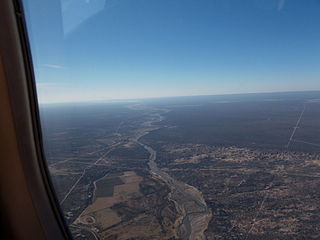 W
WThe Tunuyán River is a river in the Argentine province of Mendoza. It is born in Mount Tupungato, in the Andes range, and flows initially to the northeast, passing by the city of Tunuyán. It is then dammed by the El Carrizal Dam, after which it turns east-southeast passing near the cities of Rivadavia, Santa Rosa and La Paz. Finally, it branches into the Tunuyán Nuevo (north) and Tunuyán Viejo (south), and empties into the Desaguadero River.
 W
WThe Turbio River rises in a mountainous region of the Argentine Andes and discharges to the Última Esperanza Sound in Chile. Río Turbio headwaters are in a part of the Andes where there is no central valley, or gap between the eastern and western ridges. Not far from its mouth to the northwest lies the Cueva del Milodón Natural Monument, where remains of the extinct giant sloth have been discovered, along with evidence of habitation by early man c. 10,000 BC.
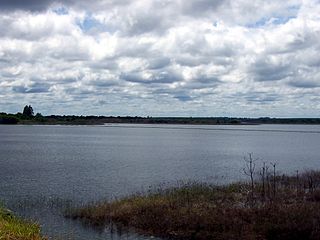 W
WThe Urugua-í River is a river in the Misiones Province of Argentina. It is a tributary of the Paraná River.